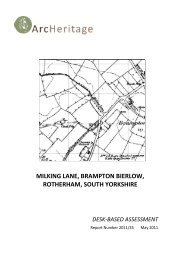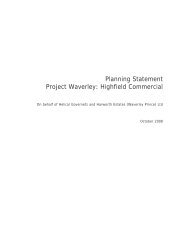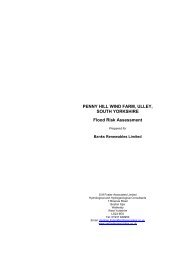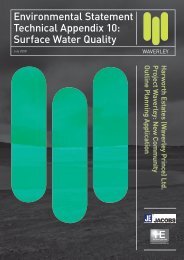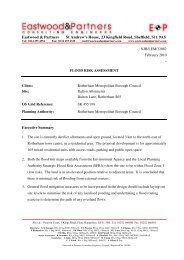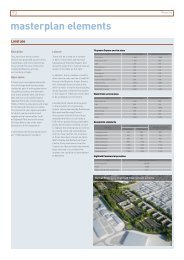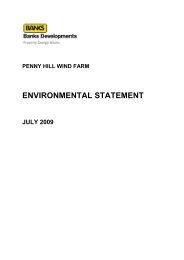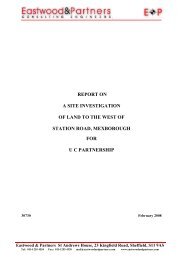environmental statement - Rotherham's Online Application for ...
environmental statement - Rotherham's Online Application for ...
environmental statement - Rotherham's Online Application for ...
You also want an ePaper? Increase the reach of your titles
YUMPU automatically turns print PDFs into web optimized ePapers that Google loves.
ASSESSMENT OF POTENTIAL EFFECTS<br />
10.14 The assessment of effects on the cultural heritage is concerned with direct<br />
(physical) and indirect (largely visual) impacts.<br />
DIRECT (PHYSICAL)<br />
10.15 Assessment of physical effects considers direct effects upon features of<br />
cultural heritage interest, whether known sites or unknown buried<br />
archaeology, which are in danger of being disturbed or destroyed. Physical<br />
impacts are likely to occur during construction and decommissioning, and<br />
are permanent and irreversible. They are discussed in the section on<br />
Potential Construction Effects.<br />
INDIRECT (VISUAL, NOISE ETC.)<br />
10.16 This assessment will take account of the potential visual effects on the<br />
settings of Scheduled Monuments, monuments registered as nationally<br />
important and Listed Buildings that exist within the proposed development<br />
site and a 15km Zone of Theoretical Visibility (ZTV) around it. The setting<br />
of a national monument or Listed Building can be loosely interpreted as<br />
features, spaces and views that are historically and functionally related,<br />
and which can be considered to be vital to their intrinsic interest. Setting<br />
can be tangible, such as a defined boundary, or intangible, such as<br />
atmosphere or ambience. The main concern <strong>for</strong> visual effects on a<br />
cultural heritage setting is the potential <strong>for</strong> the proposed development to<br />
fragment the historic landscape, separate connectivity between historic<br />
sites and impinge on views to and from sites with important landscape<br />
settings. Wind Energy and the Historic Environment (English Heritage,<br />
2005) lists visual dominance, scale, intervisibility, vistas and sight-lines as<br />
well as noise, movement and light as potential effects upon features of<br />
cultural heritage interest that might be derived from wind farm projects.<br />
Indirect effects can occur during construction, operation and<br />
decommissioning. Wind farms can have a lifespan of up to 25 years, but<br />
the visual and any other indirect effects from this <strong>for</strong>m of development are<br />
considered temporary and easily reversible.<br />
10.17 In order to identify those cultural heritage features upon whose settings the<br />
proposed development may have the potential to have an effect, an initial<br />
search area was defined. Distance was used here as the principal<br />
criterion in determining the likelihood of a significant visual effect on<br />
setting. As the landscape and visual assessment was ongoing at the<br />
same time it was not possible to derive in<strong>for</strong>mation from that at the outset<br />
of this assessment. There<strong>for</strong>e, regard was had to the indicative distances<br />
given in the Scottish Planning Advice Note - Renewable Energy<br />
Technologies (PAN 45, Revised 2002) 8 . At paragraph 78 PAN 45 notes<br />
that: „visual effects will be dependent on the distance over which a wind<br />
8 Whilst recognising that document has no weight as planning advice in England, it nevertheless<br />
provides a useful starting point in identifying the parameters <strong>for</strong> the study area.<br />
225<br />
Penny Hill Wind Farm<br />
Environmental Statement



